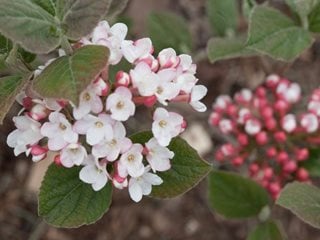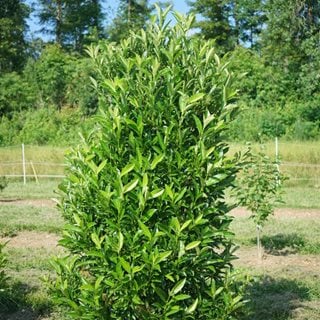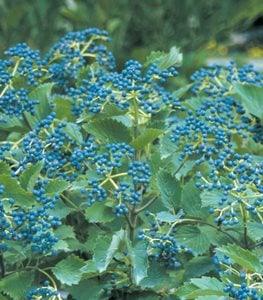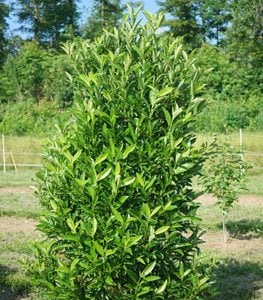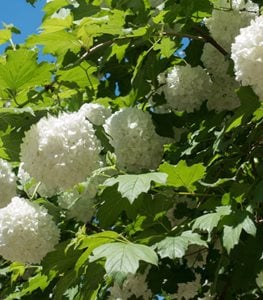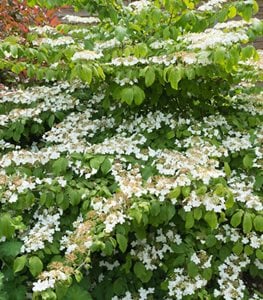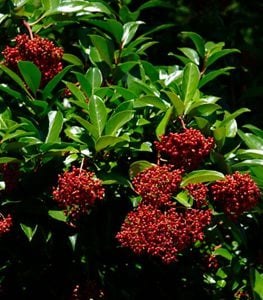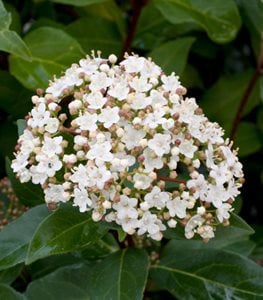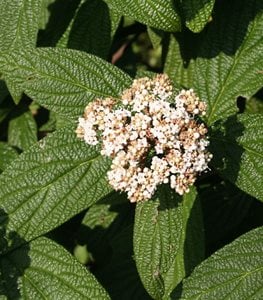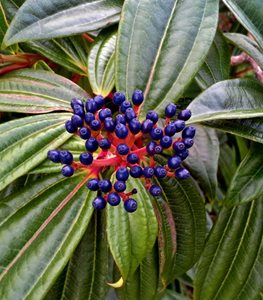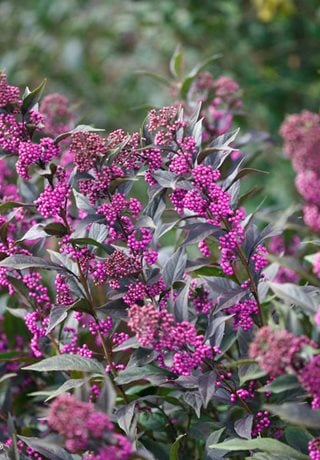Growing Viburnum Shrubs
Growing and care tips for these versatile, low-maintenance garden shrubsLooking for an evergreen, semi-evergreen or deciduous shrub that is low maintenance, deer resistant, and provides attractive foliage, abundant blooms, fall color and winter fruit for wildlife? Viburnums are the answer. With all of that going for them, it’s not hard to see why they’re one the best loved garden shrubs of all time. Learn more about viburnums and find one that fits perfectly in your garden.
On this page: Viburnum Basics | Planting | Care | Pictures | Design Tips | Companions
- VIBURNUM BASICS
- PLANTING VIBURNUM
- VIBURNUM CARE
- VIBURNUM VARIETIES
- LANDSCAPE DESIGN TIPS
- COMPANION PLANTS
VIBURNUM BASICS
Zones:
Zones 2-11, depending on variety.
Height/Spread:
There is a wide range of sizes, from a few dwarf varieties like Viburnum opulus ‘Nanum’ at just under 3 feet, to large species like V. seiboldii that may reach 20 feet tall. Most viburnums grow as shrubs and have a full-spreading habit; others can be pruned to medium-sized trees or standards.
Exposure:
Full sun to partial shade.
Seasonal interest:
Viburnums offer year-round interest with spring to summer blooms, vibrant fall color (on deciduous types) and colorful winter berries.
Color and characteristics:
Viburnums bloom with two main types of flower heads: Flat-topped clusters similar to lacecap hydrangeas and rounded snowball types. Their sometimes fragrant flowers bloom in shades of white, cream, and pink and are usually tubular or salverform (long, thin tube that widens suddenly to a flat-faced flower) in shape.
Leaves are typically oval to lance-shaped, with entire or toothed edges, and oppositely arranged. They also vary in size, texture and color. Most deciduous varieties display fantastic fall colors of yellow, red or burgundy.
Viburnums are also prized for their showy ornamental fruits that add color and interest in winter, and are an important food source for birds. Fruits are usually round or egg-shaped, and may be red, pink, purple, blue or black. Most viburnums aren’t self-pollinating and will need a little help to produce fruit. Plant 2 or 3 together for cross pollination to stimulate abundant production.
Types of viburnum:
There are many species of viburnum shrubs including Burkwood viburnum (V. x burkwoodii), David viburnum (V. davidii), Korean spice viburnum (V. carlesii), snowball bush (V. opulus), arrowwood viburnum (V. dentatum), doublefile viburnum (V. plicatum), Chindo or sweet viburnum (V. awabuki), and mapleleaf viburnum (V. acerfolium).
Toxicity:
Ingestion of the berries or fruits may cause mild stomach upset, but viburnums are not known to be toxic.
PLANTING VIBURNUM
When to plant:
Spring or fall are the best times to plant viburnums.
Where to plant:
Although the site requirements don’t vary too much between varieties, there may be subtle differences. As a general rule, full sun will produce the best blooms, berries and fall color. Some will do just as well in partial shade, especially some of the thicker-leaved varieties, but keep an eye out for black spot and other foliar diseases. They like to keep their foliage dry, so avoid planting where they might be subject to sprinkler overspray. Good air circulation is important to keep them from developing fungal diseases, but do protect them from drying winter winds.
How to plant:
To transplant a container-grown viburnum bush, dig the planting hole just as deep as the rootball and 2 to 3 times as wide. Loosen any impacted roots gently with your fingers. Place the shrub into the hole so that the top of the rootball is even with the surrounding ground level. Backfill the hole halfway and water it in to settle the bottom layer of soil. Backfill the rest of the way, and make a soil ring to hold water. Water again to settle in the rest of the way. Space according to their mature size.
VIBURNUM CARE
Pruning viburnum:
Not much pruning is required other than what is needed to maintain the shape and health of the shrub. For deciduous varieties, blooms are set in late summer, so any drastic pruning should be done immediately after flowering so next year’s blooms won’t be accidentally cut off. However, cutting back branches that just bloomed or deadheading spent blooms will decrease the amount of fruit produced in late fall and winter. For evergreen varieties, prune in late winter to early spring.
For either type, unsightly, dead or damaged branches can be thinned out any time of year. However, don’t prune or do any thinning when frost is on the way, because the new growth that follows could be damaged.
Soil:
Viburnum shrubs are quite adaptable, but do prefer organically-rich soil with a pH of 5.6 to 6.6. They also like consistently moist, but well-draining conditions.
Amendments & fertilizer:
A general-purpose fertilizer can be added in spring before new growth appears.
Watering:
During the first year, newly planted shrubs should be watered deeply and regularly, at least once a week, to help them establish a good root system. The frequency can be reduced once plants are established.
Diseases and pests:
Gray mold, rust, downy mildew, powdery mildew, wood rot, Verticillium wilt, leaf spots, and dieback can occur. Good air circulation and dry foliage are the best defenses against fungal diseases. Pests such as aphids, scale, weevils, Japanese beetles, mealybugs, spider mites, thrips, and tree hoppers are common.
Are viburnum deer resistant? Deer tend to steer clear of viburnum shrubs and it has an ‘A’ rating (rarely damaged) on the Rutgers deer-resistant plant list.
VIBURNUM VARIETIES
LANDSCAPE DESIGN TIPS
With all the variation and seasonal interest that viburnums bring to the garden, the uses are nearly endless.
- Suitable for a woodland garden or mixed border.
- Create a year-round focal point with the changing colors and blooms.
- Plant a row of upright varieties, such as Chindo Sweet viburnum or Prague viburnum, to create an impressive hedge.
- Use dwarf or more compact types, like dwarf cranberry bush, for container plantings.
RELATED:
Expert Plant Picks for Your Fall Garden
Best Flowering Shrubs for Season-Long Color
20 Fragrant Flowering Plants
Growing Loropetalum
Growing Mock Orange Shrubs
